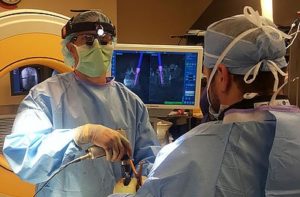
You know what is Minimally Invasive Spine Surgery?
Spine surgery has advanced dramatically with the technology surrounding minimally invasive surgical (MIS) techniques. Surgical materials, nerve monitoring, and computer-aided navigation have improved significantly recently. With these techniques, the risks, recovery time, and surgical complications have decreased greatly.

For some patients who have spinal instability or have been recommended spinal fusion, it is important to understand what minimally invasive options may be available.
Advances in spine imaging, such as MRI, allow surgeons to see smaller and smaller spinal problems. Individual spinal nerves, bone spurs, and small disc fragments can be easily seen and diagnosed. Similarly, spinal surgery techniques have advanced to the point where some procedures involve incisions less than 1 inch.
Many modern techniques can be described as “minimally invasive” surgery, or “MIS.” For some patients, a minimally invasive procedure may be a better surgical option than a traditional or “open” spinal surgery. Instead of removing muscle attachments from bones, a minimally invasive surgery spreads and pushes muscles out of the way.
X-rays, computer-aided navigation techniques, and specialized tubes or retractors with special cameras or microscopes have led to major advances in the capabilities of MIS surgery. In addition to a smaller incision, MIS surgery has several advantages. It has been shown, on average, to cause decreases in blood loss, post-operative pain and narcotic use, soft tissue damage, and number of days spent in the hospital. On average, patients have a faster recovery, and return to normal activity and work faster.
In general, most spinal surgery can be grouped into 2 categories:
- Decompression
- Fusion
Procedures to decompress nerves of the spine include removing: herniated discs, enlarged ligaments and soft tissue, and bone spurs that are pressing on spinal nerves. In some cases, motion of the spine may become unstable or painful, either from wear and tear, trauma, or from a decompression procedure. These patients may be offered spinal fusion. There are MIS options and techniques available for both types of spinal surgery.
Minimally Invasive Decompression
A normal spinal canal is filled with fluid that surrounds the spinal cord and nerves. As the spine degenerates, spinal joints get bigger (just like the knuckles on our fingers), and discs may collapse or bulge. As this happens, room for the spinal cord and roots decreases and this may lead to pain or weakness in the legs. In severe cases, a minimally invasive surgical procedure may not be an option, and an “open” procedure may be the best choice to remove arthritic bone spurs. However, for some patients where spinal stenosis is in only 1 or 2 levels, a minimally invasive surgery may be a better option with a quicker recovery.
Bone spurs and arthritis is removed from the spine where nerves are compressed using a tube or retractor that is often less than an inch in diameter. A high-powered surgical microscope is used through the tube so that the nerves can be safely seen and protected throughout the operation. This smaller incision, less muscle disruption, and preservation of more of the patient’s anatomy may lead to a quicker recovery, and physical therapy can begin sooner.
Minimally Invasive Spinal Fusion
Spinal fusion is always a major undertaking, and any patient considering it should understand the risks and recovery involved. Damage to nerves, infection, failure of bones to fuse properly, or the need for more surgery is all included in the risks of a minimally invasive or traditional “open” surgery. For this reason, it is important that patients consider and fail all possible non-surgical or “conservative” methods with their surgeon before making the decision to undergo spine surgery. These non-surgical treatments include physical therapy, heat/ice, anti-inflammatory or neurologic-acting medication, bracing, or spinal injections before surgery.
Instrumentation used to fuse vertebrae together is placed under x-ray guidance through small and specialized retractors, with an incision about an inch and a half or less in length. Through the same retractors, bone spurs are removed, and spinal nerves are decompressed using a high-powered surgical microscope. For these patients, a smaller incision and less muscle disruption may lead to a quicker recovery and less post-operative pain.
When spine surgery is recommended, it is important for patients to discuss minimally invasive options with their surgeon.
Minimally invasive surgery, or “MIS,” is not the right option for all patients. It is important to understand why you may not be a candidate for MIS. Some surgeons have not been trained using these techniques, and do not offer them even though their patients may benefit. Before undergoing a spinal surgery, you should have a good understanding of the procedure itself and what to expect during the recovery process. Since pain and recovery are personal and individualized for each patient, no surgeon can guarantee a particular recovery course. However, for many patients, an MIS option may result in a smoother and more successful outcome.


